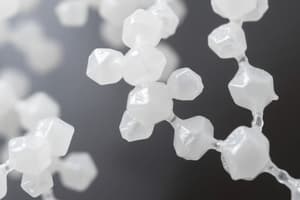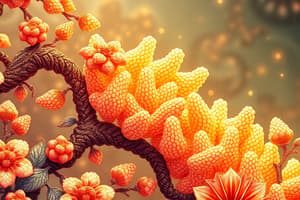Podcast
Questions and Answers
Which disaccharide is formed by the glycosidic bond between glucose and galactose?
Which disaccharide is formed by the glycosidic bond between glucose and galactose?
- Lactose (correct)
- Sucrose
- Maltose
- Cellulose
What type of reaction creates the glycosidic bond between two monosaccharides?
What type of reaction creates the glycosidic bond between two monosaccharides?
- Condensation (correct)
- Hydrolysis
- Oxidation
- Reduction
Which property makes sucrose an effective transport sugar in plants?
Which property makes sucrose an effective transport sugar in plants?
- Its high solubility enables transport in high concentrations. (correct)
- Its insolubility prevents leakage.
- Its reactivity allows for easy modification.
- Its compact size facilitates quick movement.
Why are polysaccharides like starch and glycogen suitable for energy storage?
Why are polysaccharides like starch and glycogen suitable for energy storage?
What is the primary structural difference between amylose and amylopectin?
What is the primary structural difference between amylose and amylopectin?
Cellulose is a structural polysaccharide found in plants. Which characteristic makes it well-suited for this function?
Cellulose is a structural polysaccharide found in plants. Which characteristic makes it well-suited for this function?
If a disaccharide is hydrolyzed, what type of molecules are produced?
If a disaccharide is hydrolyzed, what type of molecules are produced?
Which of the following is a storage polysaccharide commonly found in humans?
Which of the following is a storage polysaccharide commonly found in humans?
Which of the following is a defining characteristic of monosaccharides?
Which of the following is a defining characteristic of monosaccharides?
Which of the following is NOT a hexose sugar?
Which of the following is NOT a hexose sugar?
What process links two monosaccharides together to form a disaccharide?
What process links two monosaccharides together to form a disaccharide?
Which of the following best describes the general formula for monosaccharides?
Which of the following best describes the general formula for monosaccharides?
Considering the properties of monosaccharides, which of the following is the most likely reason they are easily transported in living organisms?
Considering the properties of monosaccharides, which of the following is the most likely reason they are easily transported in living organisms?
If a researcher discovers a new carbohydrate with the molecular formula C12H24O12, how would it likely be classified?
If a researcher discovers a new carbohydrate with the molecular formula C12H24O12, how would it likely be classified?
A scientist is studying a metabolic pathway and observes that a certain carbohydrate molecule is broken down into smaller units. Which of the following is LEAST likely to be the starting molecule?
A scientist is studying a metabolic pathway and observes that a certain carbohydrate molecule is broken down into smaller units. Which of the following is LEAST likely to be the starting molecule?
In a laboratory experiment, two different monosaccharides combine to form a disaccharide. What else would you expect to find as a product of this reaction?
In a laboratory experiment, two different monosaccharides combine to form a disaccharide. What else would you expect to find as a product of this reaction?
Why is the permeability of plant cell walls important for the survival and function of plant cells?
Why is the permeability of plant cell walls important for the survival and function of plant cells?
Why are monosaccharides biologically important?
Why are monosaccharides biologically important?
In the Benedict's test, what is the role of the reducing sugar?
In the Benedict's test, what is the role of the reducing sugar?
Why does the Benedict’s test for reducing sugars involve the use of an alkaline solution?
Why does the Benedict’s test for reducing sugars involve the use of an alkaline solution?
How would you modify the Benedict’s test to accurately test the concentration of glucose in a colorless solution?
How would you modify the Benedict’s test to accurately test the concentration of glucose in a colorless solution?
Which of the observations is correctly matched with the relative amount of reducing sugars in a Benedict’s test?
Which of the observations is correctly matched with the relative amount of reducing sugars in a Benedict’s test?
Why is hydrochloric acid added to a sample when testing for non-reducing sugars?
Why is hydrochloric acid added to a sample when testing for non-reducing sugars?
Sucrose yields a negative result in the Benedict's test but a positive result after treatment with hydrochloric acid. Why?
Sucrose yields a negative result in the Benedict's test but a positive result after treatment with hydrochloric acid. Why?
Flashcards
Maltose
Maltose
A disaccharide made of two glucose molecules.
Lactose
Lactose
A disaccharide composed of glucose and galactose.
Sucrose
Sucrose
A disaccharide formed from glucose and fructose.
Glycosidic Bond
Glycosidic Bond
Signup and view all the flashcards
Polysaccharides
Polysaccharides
Signup and view all the flashcards
Starch
Starch
Signup and view all the flashcards
Glycogen
Glycogen
Signup and view all the flashcards
Cellulose
Cellulose
Signup and view all the flashcards
Monosaccharides' role
Monosaccharides' role
Signup and view all the flashcards
Reducing Sugars
Reducing Sugars
Signup and view all the flashcards
Benedict’s Test
Benedict’s Test
Signup and view all the flashcards
Benedict's Test Principle
Benedict's Test Principle
Signup and view all the flashcards
Benedict’s Test - Quantitative?
Benedict’s Test - Quantitative?
Signup and view all the flashcards
Non-Reducing Sugar
Non-Reducing Sugar
Signup and view all the flashcards
Non-Reducing Sugar Test
Non-Reducing Sugar Test
Signup and view all the flashcards
Carbohydrates
Carbohydrates
Signup and view all the flashcards
Carbohydrate General Formula
Carbohydrate General Formula
Signup and view all the flashcards
Monosaccharide
Monosaccharide
Signup and view all the flashcards
Monosaccharide Formula
Monosaccharide Formula
Signup and view all the flashcards
Examples of Hexose Sugars
Examples of Hexose Sugars
Signup and view all the flashcards
Disaccharide
Disaccharide
Signup and view all the flashcards
Condensation Reaction (Carbohydrates)
Condensation Reaction (Carbohydrates)
Signup and view all the flashcards
Disaccharide Formation
Disaccharide Formation
Signup and view all the flashcards
Study Notes
- Carbohydrates contain carbon, hydrogen, and oxygen
- The general formula for carbohydrates is Cx(H2O)y, where x and y are variable numbers
Structure of Carbohydrates
- Carbohydrates include monosaccharides, disaccharides, and polysaccharides
Monosaccharides
- Monosaccharides cannot be further hydrolyzed into simpler carbohydrates
- The general formula for monosaccharides is (CH2O)n
- Examples of monosaccharides include glucose, fructose, and galactose (hexose sugars)
Disaccharides
- Disaccharides form through condensation reaction between two monosaccharides, with the removal of one water molecule
- Common examples of disaccharides:
- Maltose consists of glucose + glucose
- Lactose consists of glucose + galactose
- Sucrose consists of glucose + fructose
- The bond between two monosaccharides is called a glycosidic bond
Polysaccharides
- Polysaccharides are polymers of monosaccharides
- Common examples of polysaccharides:
- Starch which is a storage polysaccharide in plants
- Glycogen which is a storage polysaccharide in humans
- Cellulose which is a structural polysaccharide in plants
- Starch is a polymer of glucose with amylose and amylopectin components
- Amylose has a straight chain structure with a helical shape and consists of thousands of glucose units joined by glycosidic bonds
- Amylopectin is compact, branched structure with glucose units held together by glycosidic bonds and has twice as many glucose units as amylose
Functions of Carbohydrates
- Carbohydrates are a source of energy
- Sucrose transports sugar in phloem of plants, and its ability to flow at high concentrations because it is soluble; also it is chemically unreactive
- Polysaccharides like starch and glycogen are good storage molecules that are easily hydrolyzed into monosaccharides
- Cellulose is a structural polysaccharide, found in all plant cell walls, has good tensile strength, and is permeable to water and solutes
- Monosaccharides are required for nucleic acid synthesis (deoxyribose is a constituent of DNA, ribose is a constituent of RNA), disaccharides and polysaccharides
Tests for Carbohydrates
- There are different methods to detect reducing sugars, non-reducing sugars, and starch
Test for Reducing Sugars
- All monosaccharides and some disaccharides (e.g. lactose and maltose) are reducing sugars
- Sucrose (common table sugar) is a non-reducing sugar
- Benedict's test can detect the presence of reducing sugars
- Reducing sugars reduce copper from a valency of 2 to 1
- Benedict's test involves an alkaline solution of copper(II) sulfate (CuSO4), which is reduced to insoluble copper(I) oxide (Cu2O), forming a brick-red precipitate
- The test is semi-quantitative, greater reducing sugar levels result in more brick-red
- The colour changes with increasing concentrations of reducing sugar goes as follows:
- No reducing sugar: Blue solution
- Large amounts of reducing sugar: Green -> Yellow -> Brown -> Red (suspension)
- If there is no precipitate, there are no precipitate at all; If there is a lots of precipitate, there are large amounts of precipitates
Test Non-Reducing Sugar (Sucrose)
- If the reducing sugar test is negative (remains blue), the test for non-reducing sugars can proceed
- Method:
- Add a few drops of hydrochloric acid to 2 cm³ of the test sample in a test tube
- Heat the mixture for 2 minutes in a hot water bath to hydrolyze sucrose into glucose and fructose
- Neutralize the acid by adding sodium hydrogen carbonate until effervescence stops
- Carry out the Benedict's test again
- If non-reducing sugars were present, the Benedict's test will turn positive
Test for Starch
- Method:
- Add a few drops of iodine-potassium iodide solution to the test sample in a test tube or on a white tile
- Observe any colour change
- Observations:
- The brown (or yellow) solution turns dark blue if starch is present
- Iodine takes up position in the centre of the amylose helix to form a dark blue starch-iodide complex
- The solution remains brown (or yellow) if starch is absent
Studying That Suits You
Use AI to generate personalized quizzes and flashcards to suit your learning preferences.




